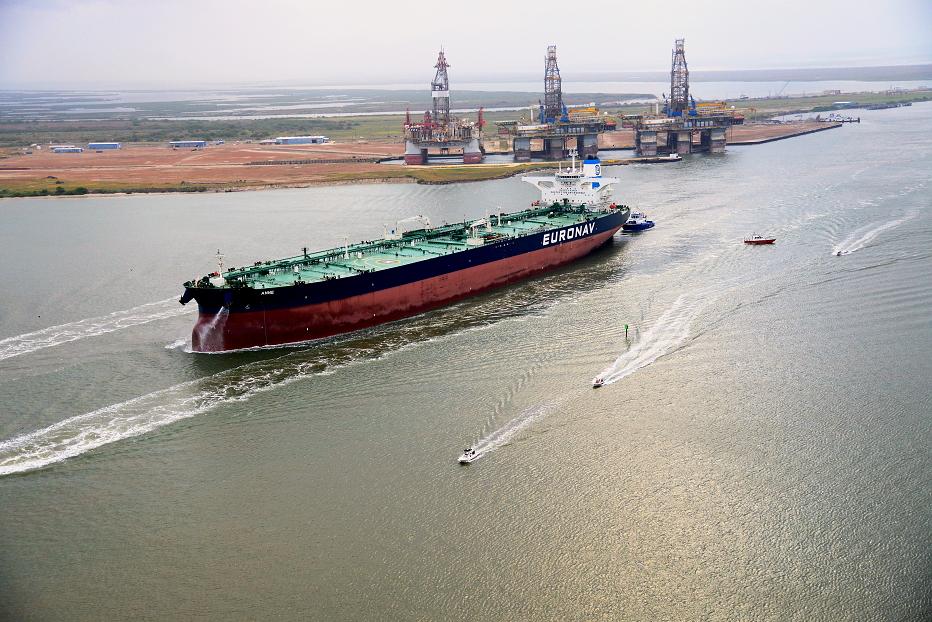Energy Transfer Expects Supertanker Facility in Service by 2023
NEW YORK (Reuters) — Energy Transfer LP said on Thursday discussions with potential shippers to build an offshore crude export facility in Texas capable of handling supertankers were progressing on schedule, with the project expected to be in service by late 2022 or early 2023.
The company has also made advances on the regulatory and permitting process for the project, Marshall McCrea, Energy Transfer's chief commercial officer, said on the company's quarterly earnings call.
Plans call for the facility to be connected to Energy Transfer's Nederland, Texas, crude terminal, though a final investment decision has not yet been made, Chief Financial Officer Thomas Long said.
U.S. crude exports surged to record highs above 3 million barrels per day (bpd) after Washington lifted a ban in late 2015. Several midstream companies have raced to add export terminals capable of handling Very Large Crude Carriers (VLCCs) along the U.S. Gulf Coast.
Energy Transfer said the Permian Express 4 crude pipeline expansion, which added an additional 120,000 bpd of capacity to its Permian express pipeline system from Colorado City, Texas, to Nederland went into full service on Oct. 1 and is currently operating at full capacity.
In September, Energy Transfer said it would buy smaller rival SemGroup Corp for $1.35 billion and build the new Ted Collins pipeline between the Houston Ship Channel and Nederland.
That pipeline is expected to have an initial capacity of more than 500,000 bpd and commercial operations are likely to begin in 2021, Energy Transfer said.
In July, the company announced an open season for the Dakota Access pipeline system, soliciting additional shipper commitments in order to expand capacity.
As a result of increased customer interest as well as the SemGroup acquisition and the Ted Collins pipeline project, Energy Transfer said it has extended and modified the current supplemental open season to include the Houston Fuel Oil Terminal (HFOTCO) as a destination for shippers.
The capacity to serve the commitments received during the open season is expected to be in service in early 2021, the company said.
Energy Transfer will be capable of expanding the system's capacity up to 1.1 million bpd over time based upon customer demand, from about 570,000 bpd currently, the company has said.
"In the meantime, and upon completion of the permitting phase, we expect to provide up to approximately 30,000 barrels per day of incremental capacity by mid-2020, utilizing current system configuration," Long said.
Related News
Related News

- Kinder Morgan Proposes 290-Mile Gas Pipeline Expansion Spanning Three States
- Enbridge Plans 86-Mile Pipeline Expansion, Bringing 850 Workers to Northern B.C.
- Intensity, Rainbow Energy to Build 344-Mile Gas Pipeline Across North Dakota
- Tallgrass to Build New Permian-to-Rockies Pipeline, Targets 2028 Startup with 2.4 Bcf Capacity
- U.S. Moves to Block Enterprise Products’ Exports to China Over Security Risk
- U.S. Pipeline Expansion to Add 99 Bcf/d, Mostly for LNG Export, Report Finds
- A Systematic Approach To Ensuring Pipeline Integrity
- 275-Mile Texas-to-Oklahoma Gas Pipeline Enters Open Season
- LNG Canada Start-Up Fails to Lift Gas Prices Amid Supply Glut
- TC Energy’s North Baja Pipeline Expansion Brings Mexico Closer to LNG Exports





Comments